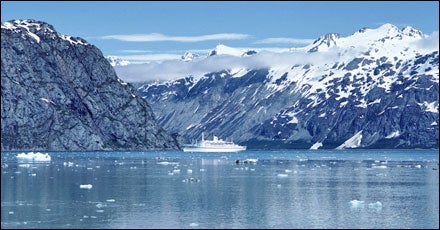WITH TOURISM BOOMING in Antarctica and commercial ships carving out their share of the sea, a disaster was probably inevitable. At 12:30 A.M. on November 23, it happened: G.A.P �����ԹϺ���s’ MS Explorer, a 246-foot ice-class cruiser, hit an unidentified objectlikely an icebergand, the next night, went down in the Bransfield Strait, about 80 miles off the Antarctic Peninsula. What happened could have been a lot worse. None of the 154 people aboard perished, thanks to experienced crew, capable passengers, and a timely rescue effort. But the Explorer was fueled with nearly 50,000 gallons of diesel, and the sinking has many environmentalists calling for increased regulation of Antarctic tourism. Reporter SCOTT GOETZ was on board the Endeavour, the first of two ships to reach the Explorer. Here, he breaks down what went right and wrongand what happens next.
A Ship's Life
Since her launch in 1969, the Explorer had traveled everywhere from Antarctica to the Arctic and from Africa to the upper Amazon, racking up perhaps more miles than any other cruise ship in history. But in recent years the Explorer had been sold several times. “She was going downhillmore or less carrying backpackers,” says Oliver Kruess, chief officer of the Explorer in 199192. “A cloud hung over her that she would soon end up rusting on a beach in India. That was not her. Antarctica was her stage, her theater. That night she put her best dress on and went into the ice.”S.G.
NOVEMBER 23:
The weather is calm, with temperatures of around 23 degrees ahrenheit. The sea is unusually flat; the water is about 30 degrees.
12:30 A.M.
The Explorer is cruising through sea ice when it strikes a floating object on the ship’s starboard side. Passenger Eli Charne, 38, awake in cabin 314, hears a loud bang. “Icy-cold water was pouring down the wall,” says Charne. “There was a foot and a half in my cabin.” He soundsthe alarm.
12:35 A.M.
In less than five minutes, the ship’s 94 passengers are ordered to dress and meet in a lecture hall on the upper deck. After crew members explain that the ship is stable and rescuers are on the way, passengers with cabins on the upper floor are allowed to retrieve a few additional belongings.
1:10 A.M.
The ship’s bilge pumps become overwhelmed and the engine room floods, causing loss of power. The Explorer begins drifting toward heavy sea ice. Knowing he’ll be unable to deploy lifeboats onto the ice if he waits, Swedish captain Bengt Wiman sounds the call to abandon ship.
1:37 A.M.
Lindblad Expeditions’ Endeavour, en route from King George Island to DeceptionIsland, receives the first distress call from the Explorer. Oliver Kruess, the Endeavour captain, immediately changes course and will reach the Explorer in four hours. He also contacts the captain of the nearby Nordnorge, a 464-passenger cruise ship that, while not as ice-worthy, has some 200 empty cabins and can take all the Explorer’s passengers and crew aboard.
4:30 A.M.
All passengers are safely aboard lifeboats and Zodiac rafts. The smooth evacuation happens thanks largely to the ship’s adventure-ready passengers, who had been taking daily excursions aboard Zodiacs. “We’d had a couple of tours in very cold and rainy weather,” says Torrey Trust, 22, a San Diegobased survivor who was on her honeymoon. “Everyone was really experienced and used to Zodiacs. They knew how to dress, and it just depended on if they grabbed everything when the alarm went off. Most people did.”
5:30 A.M.
As the two rescue ships arrive, a Chilean Naval AS 355 N twin-engine utility helicopter circles above the wreck, ready to pluck passengers from the water.
6:30 A.M.
The Endeavour deploys its Zodiacs to aid in towing and releasing lifeboats as well as transferring passengers, ten at a time, to the Nordnorge. Endeavour then collects Explorer’s eight Zodiacs and brings their drivers aboard for tea while the Zodiacs are dismantled.
THE AFTERMATH
What will become of Explorer’s 50,000 gallons of fuel? Nobody’s sure. Much of it probably went down with the ship and will dribble out slowly. Diesel, which is lighter than crude but still a serious concern, tends to pool on the surface and evaporate in warmer climates. In Antarctica, it might stick around longer and pose a threat to marine wildlife. On November 26, Chilean officials confirmed a mile-long slick in the area of the sinking. Meanwhile, conservationists point out the potential for truly devastating calamities in the future, since there are no laws saying who has to pay for cleanup. A proposed 2005 annex to the Antarctic Treaty would have placed responsibility on ships’ owners, but it was never ratified. “This is a wake-up call for governments to roll up their sleeves and do some regulating,” says Jim Barnes, executive director of the Antarctic and Southern Ocean Coalition.JOE SPRING

